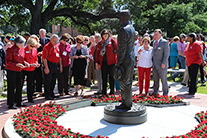A bronze statue of Dr. Edwin L. Stephens, the University of Louisiana at Lafayette’s first president, was dedicated on campus Friday, near live oaks he planted more than 100 years ago.
The outdoor, public art is next to Girard Hall, near the intersection of Johnston Street and University Avenue.
University President Dr. Joseph Savoie and former president Dr. Ray P. Authement unveiled the life-size image of Stephens during a ceremony. Alumni, faculty, staff and students attended the event. Special guests included some members of the Class of 1964, who are celebrating their Golden Reunion this weekend.
Stephens was just 27 when he was named president in 1900 by the school’s board of trustees. He was teaching chemistry and physics at Boy’s High School in New Orleans.
“History proved that the board of trustees made an excellent choice. He was intelligent, tireless and passionate about building a higher education institution for the ages,” Savoie said during the ceremony.
During his 38-year tenure, Stephens helped transform an empty sugar cane field into a college campus. He directed construction of the school's first buildings and the expansion of its curriculum. Under his leadership, it began granting bachelor's degrees.
Sculptor Patrick Miller created the life-size image of Stephens, relying on vintage photographs. He created the sculpture in his Ponchatoula, La., studio.
The statue’s details reflect Stephens’ legacy. For example, he holds an acorn in his right hand.
Stephens was an advocate for the trees. In addition to planting oaks on campus, he established the Live Oak Society, a registry of mature live oaks that now includes more than 7,000 trees in 14 states.
A photo taken when Stephens was a young man shows that fleurs-de-lis were embroidered on the fabric of his ascot. Miller repeated the design on the statue.
In 1926, Stephens helped design the school’s seal; he included the fleur-de-lis to represent Louisiana’s historical connection to France. Today, the stylized lily is also part of the University’s academic logo. It recognizes Acadiana’s French heritage and is a symbolic connection between the past and present.
University adds public art to campus to honor its first president
Published
